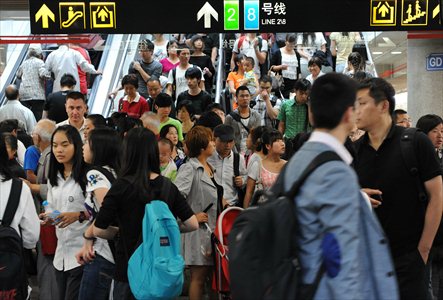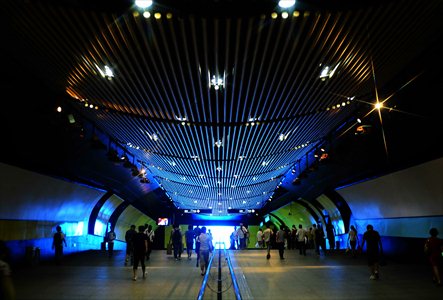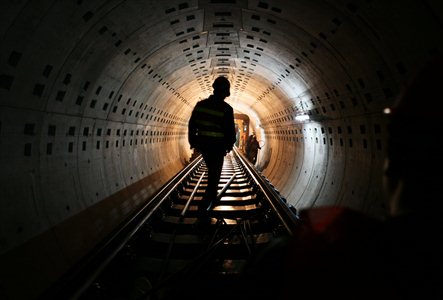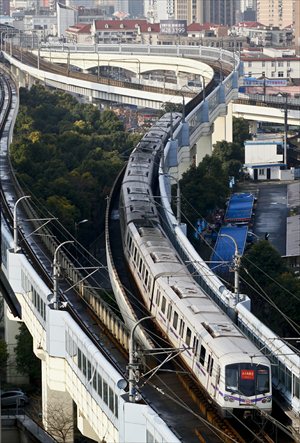Keeping up to speed
Shanghai's metro system is one of the most modern in the world, the largest subway system in China and now an indispensable mode of transport for the 7 million citizens who use it every day.




It nearly didn't happen. In the 1950s experts from the former Soviet Union told authorities that the soft clay earth of Shanghai was unsuitable for building a subway system. Political upheavals took their toll as well, soon after building commenced.
One man saw it all happen and has been closely involved from the very beginning to the present day. Yu Jiakang began planning today's metro system 50 years ago and was the senior designer for five of the city's subway lines.
These days the spritely 73-year-old Yu is the chief engineering designer for the Shanghai Tunnel Engineering and Rail Transit Design and Research Institute. Commonly known by friends and colleagues as "Master Yu" he is the only rail engineer to be named a Master of Engineering in China, an honor bestowed by the Ministry of Housing and Urban-Rural Development. He was the chief designer for Shanghai's subway Lines 1, 2, 4, 5, 8 and some extensions. He has been involved closely in most of the planning for Shanghai's subway system
Plans for a subway system in Shanghai were first mooted in 1956 although at that time the underground tunnels planned would have also served as bomb shelters in case of war. In 1967 Yu was one of the first engineering graduates from Tongji University and that was the year he began work on a 600-meter trial tunnel in today's Hengshan Road. At that stage he was working under the dean of Tongji University, Li Guoxiong. However the onset of the Cultural Revolution (1966-76) interrupted their work and the building of the subway line did not begin again until 1978.
The first phase
But it was 1983 before the Shanghai municipal government approved plans for the first phase of Line 1, from Jinjiang Park to the Shanghai Railway Station, and including 13 stations across the most prosperous area of Shanghai at the time. Yu was appointed chief designer for the project.
"I led a team of eight and we went to Hong Kong to study their subway system," Yu recalled. Hong Kong had opened its first subway line in 1979. Yu said the design and construction standards for Shanghai's Line 1 were based on the Hong Kong model.
After years of planning, construction work on Line 1 began in 1990. Although the project was funded by foreign capital in some $300 million in loans from Germany, the US and France as well as the city purchasing the rolling stock from overseas companies, the design and construction of the line only involved Chinese.
On the first test run in 1993, a train that left from the southern terminal suffered a power failure and could not make the return journey. "It was the very first time for us. We had no experience in this at all," Yu said. Fortune smiled the following day and the train's test run went smoothly.
Line 1 eventually opened on April 10, 1995 and in the first year it handled an average 600,000 passengers daily.
Even before Line 1 was finished, Yu and his team began designing Line 2. Originally Line 2 was to start from Jing'an Temple and end in Yangpu district in the city's north-east corner. However the route was changed with Pudong opening up and developing and the line was extended to the Pudong Zhangjiang High Technology Park.
Today Line 2 has expanded to be the city's longest and busiest subway line, carrying 1 million passengers daily across the most populated areas of Shanghai and linking the city's two airports.
In 2000, Line 3, the first elevated subway line, opened while the first loop line, Line 4, came into operation in 2005. Yu explained that originally Line 3 was planned to run underground but then the Shanghai Railway Bureau suggested that the subway could make use of disused overhead railway lines. And the surrounding areas which were rundown could be rebuilt.
By the end of 2007, Line 6, and first phase of Lines 8, 9, 11 were opened. By 2010 before the World Expo 2010 opened the city had more than 400 kilometers of subway railway, the most of any city in the country.
From then the Shanghai subway network developed at breakneck speed.
In 1959 the city government carried out a survey of 1.09 million residents living downtown to assess the major passenger flows from homes to workplaces. The survey showed that the two major flow directions were from west to east (from Zhongshan Park to the Bund and then to Yangpu district) and south to north (from Xujiahui to People's Square). These accounted for one third of the entire traffic for the city. These facts were vital for the design of Lines 1 and 2.
Between 1990 and 2000, Shanghai built 11 subway lines, forming its basic subway network which was based on the French "RML" system. A 2006 Shanghai subway network plan would have divided the network into urban express lines designed to carry passengers from the suburbs to the city, the city lines that operate downtown which have stations closer together to serve the denser area, and lighter subway lines to link and supplement the suburban and city lines.
But when Shanghai won the rights to stage the 2010 World Expo, the RML scheme was felt impractical and the entire system was revised, partly based on the extreme demands that would be placed on the network during the Expo.
In 2009 Shanghai announced it would have 21 lines operating by 2020 with lines extending further into the suburban areas.
Line 11 is one of these and will become the first interprovincial subway line in China by the end of this year. Residents from the town of Huaqiao in Jiangsu Province will be able to reach downtown Shanghai within 90 minutes.
More changes
And more changes are on the way. Fu Deming, the senior engineer with the Shanghai Shentong Metro Group, which operates the Shanghai subway system, told the Global Times that a new blueprint for the system was already being planned. It is reported that this will focus more on expanding lines to remote areas and establishing more interchanges on different lines. Light rail links are also being considered - they would be smaller than regular subway trains but faster and would operate in set areas.
"We have a goal that passengers will be able to travel between any two points in the downtown area within 45 minutes, in suburban areas within 60 minutes and within 90 minutes throughout the Yangtze River delta," Fu said.
George Hu is the founder and administrator of the Shanghai Metro Fans' Club, the largest online metro enthusiasts' group and he has been closely watching the development of the Shanghai subway system for the past decade. He told the Global Times he thought there had been a lack of foresight in some of the subway projects.
He said, for example, Line 6 was originally designed as a supplementary line in Pudong New Area and used smaller six-carriage trains. However, with more communities being built along the line, the population using the line had burgeoned. As a result Line 6 is now one of the most crowded lines in the city.
"Apart from Lines 1 and 2, none of the Shanghai subway lines use eight carriage trains like they do in Hong Kong," Hu said.
A survey to members of his group found that many people wanted to see more interline connections rather than the radial shape the network has at present.
"At present we only have one loop line linking lines from all directions and this has to handle huge passenger flows at times causing congestion."
Master Yu did admit that the rapid development of the city had outpaced their expectations at times.
"In the past, we designated key commercial areas as sites for interchange stations because this could bring more people to those areas and help stimulate the economy. Now we realize this also brings problems with safety and crowd control," Yu said.
A new focus
These days the veteran engineer focuses on emergencies and accident prevention design. He said the city was lucky that last year's subway train accident, when two trains collided, did not result in fire.
Yu said future subway stations will be designed so that passengers can escape the area within six minutes of an incident. And if trains breakdown in tunnels there will be emergency passageways every 600 meters.
"We have included these designs in the planning for Line 11 and every subway line in future will meet these standards," Yu said.
"Now that people can move around the city easily thanks to the subway system we are focusing more on efficiency and safety - this is the big challenge for the city in the next few years and this is what we will be working on."
The subway does have its fans of course. Like 50-year-old Gu Jianming who was one of first in Shanghai to use the subway system after Line 1 opened near his home on Caobao Road. For the past 20 years he has used the subway daily to travel to his offices near the Shanghai Railway Station.
"At first, we felt strange catching an underground train but soon we appreciated its efficiency and convenience. Now, I can't imagine the life without the subway," he told the Global Times.
Another fan is 26-year-old clerical worker Liang Yaxin, a "new Shanghainese" who moved to the city from neighboring Jiangsu Province after she graduated. She travels on Line 9 every day from her home in Songjiang district to her work in downtown Huangpu district.
"I can't afford the cost of housing downtown but thanks to the subway I can live and work in Shanghai," she said.